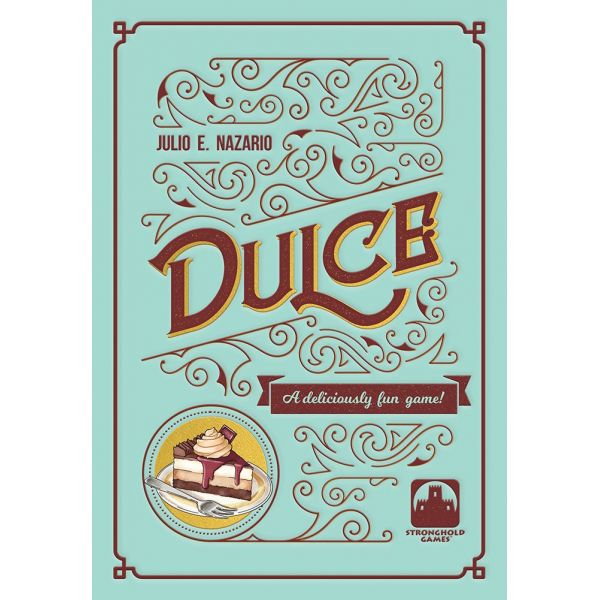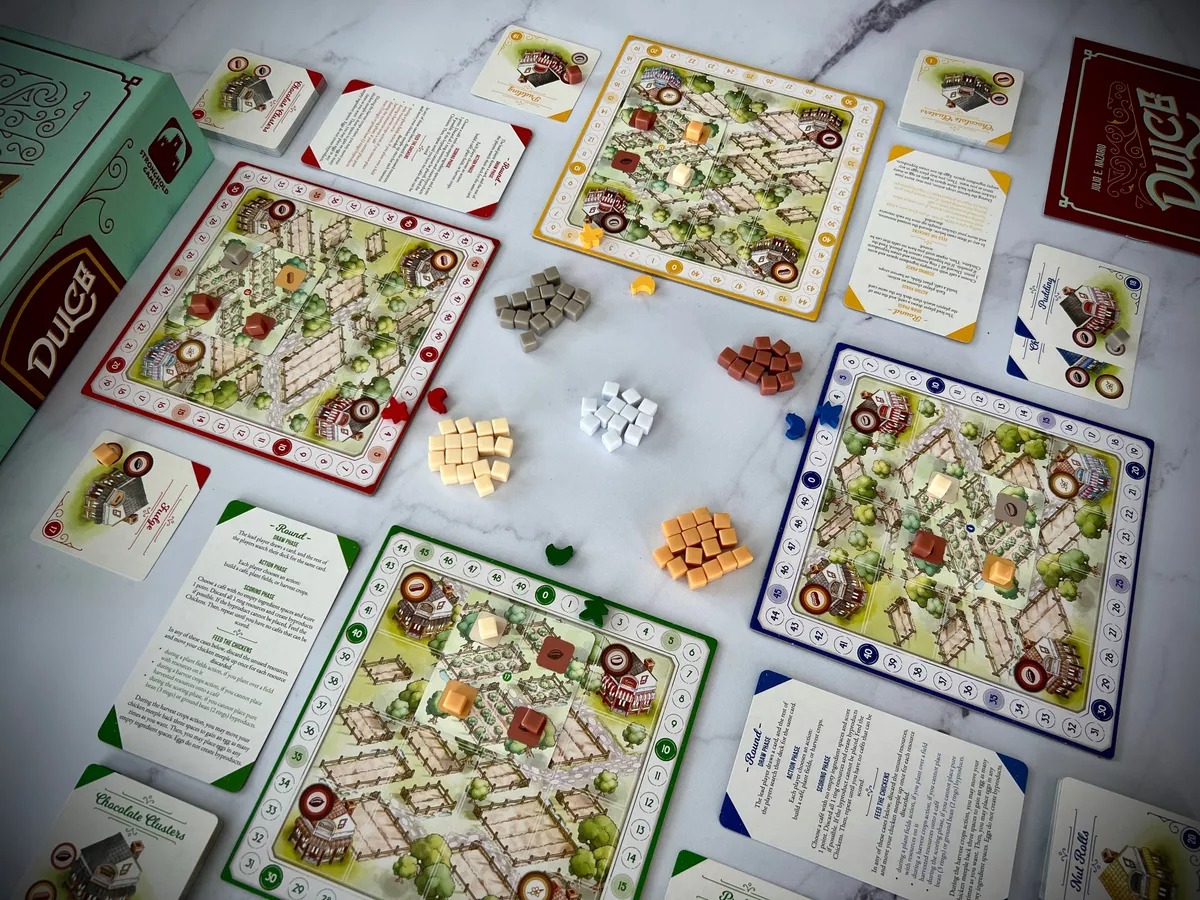Dulce Challenges All to Be the Best Confectioners

Designer Julio E. Nazario’s latest is an engine-building puzzle for 1-4 players, where knowing how to play a card is just as important as how to use it.
Gameplay
Dulce begins with each player taking a board, a baker and a chicken meeple, and a deck of cards all in their chosen player color. The baker meeple will be placed at the zero space on the scoring track, and the chicken meeple will be placed above the zero spot, just off the board. The first player will shuffle their deck of 24 cards while the rest of the players will order their cards based on the numbers and everyone will place them with the building side face-up.
Everyone’s cards are identical, and everyone will play the same card during the turn. However, the first player’s order of their shuffled deck will determine which cards the other players take and play from their own decks. As the first player (which never changes during the game) draws the top card from their deck and tells the other players the number of the card, each player will have one of three options for their cards: play the building to the side of their board as part of their tableau, flip it over to use it for its fields, or discard it to harvest beans from the fields.
Each building has two spots for different beans, each wanting a different level of beans. This is shown by the number of rings on those spots, with three rings signifying the purest bean and one ring being the lowest. How does one get the beans to fulfill the requirements of the buildings? Those are gained by flipping over the buildings to see the type of beans in each field the card will generate if planted on one’s player board, which acts as their fields. Each card has four beans on it, and when played on the board, players will grab each of the cubes that represent the vanilla, cocoa, coffee, and peanuts that players will use to fulfill the needs of any confectionary buildings they put into their tableaus. Players are able to rotate and stack cards, and stacking the same bean type over a like symbol will allow players to discard that one bean to then place two beans on that spot.
The final action players can do with a card is to discard it to harvest an entire row or column from their fields. When beans are harvested, they are considered at their purest form and can be used in the confectionery building spots to generate points when cards are completed.
This is where the game seems to be complicated, but is rather simple once it is understood. The goal of the game is to build enough of a tableau to create an engine whereas when beans degrade once they’ve been used to fulfill the needs of a building, they can pass down to another building to help fulfill its requirements. For example, if players have one confectionary that requires a level 3 vanilla bean and a level 2 peanut, they can harvest a row or column from their fields to gain a vanilla bean (among others). If a player fulfilled a building in the previous turn that needed a level 3 peanut, they may have moved their peanut to this building because it became a level 2 peanut. The player will then play a level 3 vanilla bean, fulfill the requirements of the building, and then be able to move the vanilla bean to a level 2 spot on another building, and the peanut to a level 1 spot on a building in their tableau. Player boards also have bakeries where harvested beans can be played at level 3 for a point to then use as level 2 beans on building cards in their tableau.
Players can also choose to discard beans (that haven’t been completely used from level 3 to 1) and feed their chicken. When a player does this, each bean discarded counts as one spot the chicken meeple will move on the track. Players can then move their chickens three spots back to gain an egg. An egg can only be used once (they do not degrade/downgrade by levels), but eggs are wildcards and can fulfill any spot’s requirement on any building.
As each building in a tableau is fulfilled, it earns one point but never leaves the tableau. After the last card has been drawn and played, players will finish any scoring and the player with the most points wins.

Dulce components (photo courtesy game designer Julio E. Nazario)
Review
Though the level system for beans can be complicated to understand at first, Dulce really shines as a clever puzzle game where choices matter each turn. And understanding how to leverage the system and use the beans optimally is part of the fun.
While everyone plays the same card each turn, how they play it will differ. Some will choose to use that card as a building in their tableau, others may use the field side because it will help them with the beans needed to fuel their engine. Another player may discard it to gain the beans in a row or column of their fields to trigger their engine and gain points.
Once players learn Dulce, they will be addicted to its puzzly aspects and enjoy triggering the unique engines they create. However, the rules aren’t very clear on all these choices. Explaining how beans degrade but can be used isn’t the clearest, and it’ll take a couple of plays to figure out how best to leverage beans in the system.
But you will keep playing, and play again, and play some more because games move quickly. As players begin to understand the nuances of the game, it appeals to the gamer in all of us that wishes to maximize each action to get all the beans we can, fulfill as many points as possible, and potentially feed the chicken as much as possible to then collect a lot of eggs for big points to swing the game’s outcome.
Dulce was a hot title in very short supply at Gen Con, and it’s easy to see why. As it enters the retail market, Julio Nazario’s latest puzzle-adjacent game eclipses his already solid titles in the abstract puzzle canon (Holi: Festival of Colors and CTRL). And this may also be the prettiest, most engaging of his games to date.
Pros: Excellent blend of engine building, multi-use cards, and abstract puzzle; Beautiful art and graphic design; Satisfactory feeling in building a maximal tableau
Cons: Rule book isn’t an easy read, Little player interaction.




